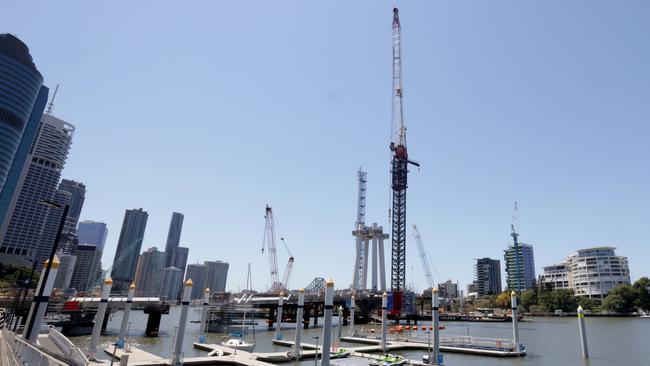‘Rapid rate’ of rental disaster engulfing Australia
It’s a crisis that doesn’t seem to be going away and if Australia continues down this path it could be “sleepwalking” into an unprecedented disaster.

Economy
Don't miss out on the headlines from Economy. Followed categories will be added to My News.
ANALYSIS
Australia’s rental market has turned diabolical.
The latest rental vacancy data from PropTrack shows that the nation’s vacancy rate plummeted to an all-time low 1.06 per cent in September, with every market across Australia experiencing extreme tightness:
The scarcity of available rental properties has pushed rental inflation to its highest in decades, with PropTrack recording capital city rental growth of 12.2 per cent in the year to September, driven by 18.2 per cent growth across Sydney, 14.9 per cent growth across Perth, and 13.6 per cent growth across Melbourne:
PropTrack pinned the blame for the tight rental market squarely on population growth:
“The ongoing rapid rate of population growth, coupled with a persistent reduction in the supply of properties available for rent, have maintained the pressure on the cost of renting, particularly in major capital cities”.
The official quarterly population data published by the Australian Bureau of Statistics (ABS) showed that Australia added an unprecedented 454,300 net overseas migrants in the year to March.
Monthly long-term arrivals and departures data released by the ABS suggests that net overseas migration (NOM) has surged even higher, with around 500,000 net migrants expected to have arrived in Australia over the 2022-23 financial year:
This level of immigration will obliterate the May federal budget’s forecast of 400,000 net NOM for the 2022-23 financial year.
The immigration boom has arrived at the same time as actual dwelling construction has collapsed.
There were only 175,200 dwellings constructed in Australia in the year to March 2023 against a total population increase of 563,200.
Reflecting that some of the homes built were ‘knock down and rebuilds’ and, therefore, did not add to overall supply, only 169,500 dwellings were added to the nation’s dwelling stock in the 2022-23 financial year, according to the ABS.
This number of supply additions was dwarfed by the 626,000 estimated increase in Australia’s resident population in the June quarter ABS national accounts.
Housing supply won’t catch up with demand
The May federal budget projected that Australia’s population would increase by 2.18 million people over the five years to 2026-27 (equivalent to the population of Perth), driven by NOM of 1.5 million people (equivalent to the population of Adelaide.
The next chart plots the federal budget’s projected population increase against actual dwelling completions, as provided by the ABS.
Bear in mind that Australia’s population growth is currently running well above the federal budget’s projection.
Regardless, Australia is sleepwalking into an unprecedented housing crisis unless it can rapidly ramp-up housing supply to meet high levels of immigration.
In August, the national cabinet announced a plan to build 1.2 million new homes over five years, starting July 1, 2024.
Federal, state and territory governments won’t build these 1.2 million homes, however. Their plan is to relax planning and zoning rules to allow higher density in the hope that private developers build them.
PropTrack senior economist, Eleanor Creagh, warned this month that “to meet the 1.2 million goal, we need to increase our pace of building by almost 40 per cent from where it currently stands”.
Worse, “based on current estimated annual growth of close to 600,000+ people per year (both natural increase and net overseas migration), the new residents will simply absorb the 1.2 million homes based on an average household size of 2.49,” Ms Creagh warned.
There are compelling reasons to believe that the national cabinet’s 1.2 million homes target has zero chance of being achieved.
First, it is not in developers’ interest to flood the market with supply because that reduces their profits. Private developers have an incentive to drip feed supply to keep prices high.
Second, national cabinet’s plan is to build 240,000 homes a year, or 660 homes a day. However, Australia has only ever built more than 220,000 homes in a year once in 2017 when it built 223,000.

Australia’s 40-year average home construction rate is only 160,000 – i.e. 80,000 less than national cabinet’s target.
How will Australia realistically build more homes than it ever has before in an environment of widespread builder collapses, shortages in materials and labour, and higher interest rates?
Third, what about the corresponding infrastructure to accommodate these new homes and population? Most roads, schools and hospitals in our major capital cities are already at capacity.
Finally, even if we could magically build these 1.2 million homes, they are likely to be low quality.
The previous decade’s construction boom was associated with widespread defects including cracking, water leaks and balcony problems, especially across the apartment space (e.g. the Opal and Mascot Towers in Sydney).
Building so many apartments as quickly as planned by national cabinet will inevitably compromise on quality leading to the same types of structural issues we witnessed last decade.
Australia’s rental crisis will worsen
Too many people competing for too few homes means that Australia’s rental crisis will inevitably worsen, and we will see the number of Australians living in share housing or becoming homeless increase.
Already, Flatmates.com.au, the nation’s largest share house website, has seen a near doubling of people seeking share housing.
National Shelter also reported that there has been a 50 per cent rise in homelessness since 2020 and a 103 per cent increase in people living in “improvised homes” and “rough sleeping”.
It is an inequality disaster in the making that will hit the younger and poorer cohorts of Australians especially hard.
Housing solution
The structural shortage of housing in Australia is a direct result of nearly 20 years of excessive immigration, which this year hit new heights and is officially projected to continue indefinitely.
The reality is that Australia will never build enough homes so long as its population continues to grow at a rapid pace via high levels of immigration.
The nation did not build enough homes in the 15 years of ‘Big Australia’ immigration leading up to the pandemic. And we have less chance of doing so now under even higher levels of immigration and when the entire housing construction sector is on its knees suffering widespread insolvencies and skyrocketing materials and financing (interest rate) costs.
If the Albanese Government genuinely cared about ending the nation’s housing crisis, it would moderate immigration to a level that is below the nation’s ability to supply housing and infrastructure, not the other way around.
Governments and housing commentators must stop pretending that a ‘lack of supply’ is the problem and address the elephant that is trampling the housing market and Australian renters.
Leith van Onselen is co-founder of MacroBusiness.com.au and Chief Economist at the MB Fund and MB Super. Leith has previously worked at the Australian Treasury, Victorian Treasury and Goldman Sachs.
Originally published as ‘Rapid rate’ of rental disaster engulfing Australia




